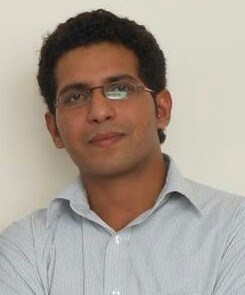Round Table — Speakers

Dmitry Yudin
Reconfigurable-metasurface-based transceiver design for 6G wireless communication
Biography:
Dmitry Yudin studied applied mathematics and physics at Moscow Institute of Physics and Technology, Russia and graduated with a PhD examination at Uppsala University, Sweden in 2015. After defending his PhD he took a position as a Research Fellow at Nanyang Technological University, Singapore, while being a long term visiting researcher at the University of California at San Diego, USA, and at Max-Planck-Institute for Quantum Optics, Germany. In 2020, he was appointed as an Assistant Professor at Skolkovo Institute of Science and Technology, where he is currently pursuing research on 6G enabling technologies and edge intelligence.
Annotation:
A reconfigurable metasurface represents an artificial structure made of elements with adjustable electromagnetic properties that are controlled with integrated electronics. The control over signal propagation, allowing to improve the coverage and signal quality, is guaranteed by low-cost and tunable passive elements which modify the signal. Those elements only reflect the incident signal with an adjustable phase shift or enable other unnatural electromagnetic functionalities. Such a system does not require a dedicated source of energy for radio-frequency processing, and is not affected by receiver noise as no ADC/DAC and power amplifiers are needed. Index modulation technique and smart radio environments with reconfigurable intelligent surfaces have been identified as enabling technology towards wireless mobile communications beyond 5G. In index modulation, one exploits the index of a subblock of the corresponding system, e.g., transmit antenna or subcarrier, to convey information. In this talk, we will be reviewing recent achievemenets and trends in reconfigurable metasurface based transceiver architecture as well as their use for index modulation.

Ertuğrul Başar (online)
Towards Networks with Extremely Low Power Consumption: From Reconfigurable Intelligent Surfaces to Thermal Noise Communication
Biography:
Ertugrul Basar received his Ph.D. degree from Istanbul Technical University in 2013. He is currently an Associate Professor with the Department of Electrical and Electronics Engineering, Koç University, Istanbul, Turkey and a Visiting Professor (Mercator Fellow) with the Faculty of Electrical Engineering and Information Technology, Ruhr-Universität Bochum, Bochum, Germany. He is the director of Communications Research and Innovation Laboratory (CoreLab) since 2018. His primary research interests include beyond 5G systems, index modulation, intelligent surfaces, waveform design, and deep learning/signal processing for communications. Dr. Basar currently serves as a Senior Editor of IEEE Communications Letters and an Editor of IEEE Transactions on Communications and Frontiers in Communications and Networks. He is a Young Member of Turkish Academy of Sciences and a Senior Member of IEEE. He is the founding Academic Chair of the IEEE ComSoc Emerging Technologies Initiative on Reconfigurable Intelligent Surfaces. He is the author/co-author of more than 120 journal publications and 7 patents that received more than 8K citations in the past five years.
Annotation:
Signal processing and communication communities have witnessed the rise of many exciting communication technologies in recent years. Notable examples include alternative waveforms, massive multiple-input multiple-output (MIMO) signaling, non-orthogonal multiple access (NOMA), joint communications and sensing, and so on. It is inevitable that 6G wireless networks will require a rethinking of wireless communication systems and technologies, particularly at the physical layer (PHY) since the cellular industry reached another important milestone with the development of 5G wireless networks with diverse applications. Within this perspective, this talk aims to shed light on the recent developments in reconfigurable intelligent surface (RIS)-empowered communication towards 6G wireless networks by putting forward promising candidates for future research and development. Specifically, we put our emphasis on active, transmitter-type, transmissive-reflective, and standalone RISs, by discussing their advantages and disadvantages. We will also cover the recent developments towards next-generation RIS-empowered communication. Finally, taking RIS-based RF chain-free transmitters one step further, we put forward the paradigm of thermal noise communication (TherCom). In this context, we discuss the potential of thermal noise-driven communication systems, which can enable zero-signal-power transmission by simply indexing resistors or other noise sources according to information bits.

Stanislav Glybovski
Microwave and Millimeter-Wave Tunable Antennas for Wireless Communications
Biography:
Stanislav Glybovski was born in Syktyvkar, Russia, in 1987. He received the M.Sc. and Ph.D. degrees in radiophysics from St. Petersburg State Polytechnic University, Saint Petersburg, Russia, in 2010 and 2013, respectively. He is currently a Leading Researcher with the School of Physics and Engineering, ITMO University, Saint Petersburg. His current research interests include antennas and microwave devices, computational electromagnetics, metamaterials, and magnetic resonance imaging (MRI). He is a director of a Master’s degree educational program on radio science at ITMO University. He is the author/co-author of more than 45 journal publications and 13 patents that received more than 1800 citations in the past five years.
Annotation:
Novel and prospective wireless communications use higher operational frequencies and wider bands associated with strong signal losses both in the radio channel and inside the antenna. Therefore, more directive antennas are to be used. Finally, MIMO and dynamic beam steering regimes require electrically tunable/switchable operation of the antennas. Solving all the above-mentioned problems is currently a challenging task for antenna designers. In this talk, we review the most promising approaches to building electrically tunable antennas in the microwave and millimeter-wave ranges. We discuss the advantages and drawbacks of various controlling elements used in such designs as reflect- and transmit-arrays and steerable leaky-wave antennas. The role of metasurfaces in the antennas will be highlighted and the possibilities of their sub-THz operation will be considered.

Georgios Alexandropoulos (online)
Metasurface-Based Holographic MIMO transceivers for 6G Communications and Sensing
Biography:
George C. Alexandropoulos received the Engineering Diploma, M.A.Sc., and Ph.D. degrees in Computer Engineering and Informatics from the School of Engineering, University of Patras, Greece in 2003, 2005, and 2010, respectively. He has held research positions at various Greek universities and research institutes, as well as at the Mathematical and Algorithmic Sciences Lab, Paris Research Center, Huawei Technologies France, and he is currently an Assistant Professor with the Department of Informatics and Telecommunications, School of Sciences, National and Kapodistrian University of Athens (NKUA), Greece. He also serves as a Principal Researcher for the Technology Innovation Institute, Abu Dhabi, United Arab Emirates. His research interests span the general areas of algorithmic design and performance analysis for wireless networks with emphasis on multi-antenna transceiver hardware architectures, active and passive reconfigurable metasurfaces, integrated communications and sensing, millimeter wave and THz communications, as well as distributed machine learning algorithms. He currently serves as an Editor for IEEE Transactions on Communications, IEEE Wireless Communications Letters, ELSEVIER Computer Networks, Frontiers in Communications and Networks, and the ITU Journal on Future and Evolving Technologies. In the past, he has held various fixed-term and guest editorial positions for IEEE Transactions on Wireless Communications and IEEE Communications Letters, as well as for various special issues at IEEE journals. Prof. Alexandropoulos is a Senior Member of the IEEE Communications, Signal Processing, and Information Theory Societies as well as a registered Professional Engineer of the Technical Chamber of Greece. He is also a Distinguished Lecturer of the IEEE Communications Society. He has participated and/or technically managed more than 10 European Union (EU) research and innovation projects, as well as several Greek and international research projects. He is currently NKUA's principal investigator for the EU H2020 RISE‑6G research and innovation project dealing with RIS-empowered smart wireless environments. He has received the best Ph.D. thesis award 2010, the IEEE Communications Society Best Young Professional in Industry Award 2018, the EURASIP Best Paper Award of the Journal on Wireless Communications and Networking 2021, the IEEE Marconi Prize Paper Award in Wireless Communications 2021, and a Best Paper Award from the IEEE GLOBECOM 2021.
Annotation:
Next generation wireless base stations and access points will transmit and receive using extremely massive numbers of antennas. A promising technology for realizing such massive arrays in a dynamically controllable and scalable manner with reduced cost and power consumption utilizes surfaces of radiating metamaterial elements, known as metasurfaces. To date, metasurfaces are mainly considered in the context of wireless communications as passive reflecting devices, aiding conventional transceivers in shaping the propagation environment. In this talk, an alternative application of metasurfaces as holographic Multiple-Input Multiple Output (MIMO) wireless systems, with advanced analog signal processing capabilities for next generation transceivers, will be presented. A convenient model for their radiation and reception will be presented together with analyses on their main advantages as well as their effect on the ability to communicate in wireless networks in reliable and energy efficient manners. Research and implementation challenges arising from the application of metasurface-based antennas for extreme massive MIMO transceivers will be discussed together with their recent considerations for millimeter-wave and sub-THz near-field communications and integrated communications and sensing.

Suneel Yadav
mmWave assisted Vehicular Communications
Biography:
Suneel Yadav received his PhD degree in the Discipline of Electrical Engineering at Indian Institute of Technology Indore, Madhya Pradesh, India, in 2016. He is currently an Assistant Professor in the Department of Electronics and Communication Engineering, Indian Institute of Information and Technology Allahabad, India. He is serving as a faculty in-charge of Mobile and Wireless Networks Laboratory (MoWiNeT Lab). His current research interests are in the areas of physical layer security, cooperative relaying communications, intelligent reflecting surfaces, vehicular communications, and ambient backscatter communications. He is the author/co-author of more than 60 reputed journal and conference publications and 2 patents. He is also contributing in various government funded research projects; secure and spectral efficient simultaneous wireless information and power transfer systems for wireless networks, development of smart agriculture drones, an artificial intelligence-based system for non-invasive detection of Parkinson’s disease, development of IoT security test-bed, STI Hub on ICT, etc.
Annotation:
The rapid developments in the field of autonomous connected vehicles in the last few years have led to a surge in lucrative intelligent transportation system (ITS) applications, such as better on-road safety and traffic management, infotainment services, and vehicle platooning. Realizing these indispensable applications, vehicle-to-everything (V2X) communications may serve as an important pillar for autonomous connected vehicles. However, partial and fully automated vehicles require reliable, low delay, and high transmission data rate in order to satisfy the requirements of automotive-related applications. At present, Dedicated Short Range Communication and Long Term Evolution-Advanced (LTE-A) support V2X communication architecture, but they are unable to transfer large amounts of data that will be generated by connected vehicles. To this end, the mmWave frequency band is a promising candidate solution for intelligent vehicular networks, since there is a huge amount of available channel bandwidth at this frequency band. In particular, vehicles can share raw sensor data with nearby vehicles using mmWave V2V links whereas mmWave V2I links are used to send data to the cloud, by utilizing several bands, such as 5G bands of 28 GHz and 38 GHz. With this, the main aim of this discussion is to shed some insights into the recent developments in the field of mmWave-enabled vehicular communications. Specifically, our focus will be on radio coverage and connectivity, context information-based beam alignment, transient link blockage in V2X, and handover in mmWave-enabled vehicular communications. Finally, we will cover the various applications of vehicular mmWave communications under the following categories; traffic safety and flow management, and comfort-related applications.